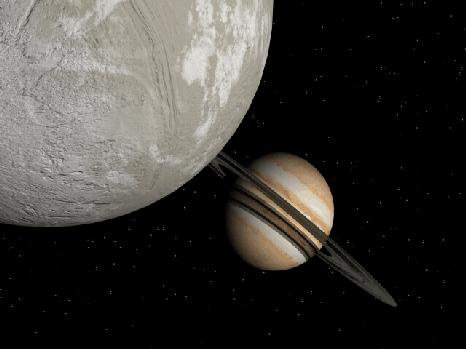
|
Credit & Copyright: John Whatmough,
Extrasolar Visions
Explanation:
Within the last few years, observational astronomy has given humanity
evidence of the existence of worlds beyond the
solar system. Indeed, solar-type stars are now inferred to
harbor planets of approximately
Jupiter mass - some residing in temperature zones
which could conceivably
support liquid water and
therefore life!
Above is a hypothetical scene near one such planet
whose sun, 47 Ursae Majoris (47 UMa), is a yellow dwarf star
(spectral class G0 V) very similar to our own. In our sky, it
appears as a faint, inconspicuous
star below the cup of the
northern hemisphere asterism, "the Big Dipper".
(Our own sun would be equally inconspicuous
when viewed from 47 UMa ...)
Astronomer's G. Marcy and P. Butler announced the
discovery of a planet associated with this star
in 1996 and reported it to have a mass of
about 2.4 Jupiters or more with an orbital period of 3 years.
This artist's vision pictures the detected planet,
referred to as 47 UMa b, as a gas giant surrounded by a ring of
material - analogous to our own
gas giant Saturn.
In the foreground lies a hypothetical moon of 47 UMa b.
Could such a moon support life?
47 UMa is only 44 light years distant, fairly
close by astronomical standards - yet there is evidence for
planetary systems which are closer still.
NASA plans to explore nearby planetary systems using spaceborne
observatories.
APOD News:
RJN to MTU
|
January February March April May June July August September October November December |
| ||||||||||||||||||||||||||||||||||||||||||||||||
NASA Web Site Statements, Warnings, and Disclaimers
NASA Official: Jay Norris. Specific rights apply.
A service of: LHEA at NASA / GSFC
& Michigan Tech. U.
Based on Astronomy Picture
Of the Day
